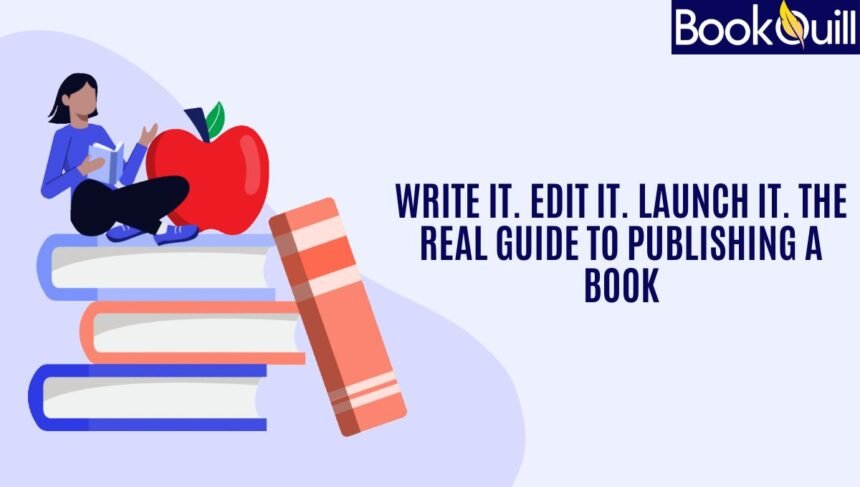It was mid-December. The weather was harsh, the climate was cold, and snow was falling from the skies like balls of cotton, covering entire alleyways in a blanket of white. I was in my attic, finally about to finish what had started merely as a hobby and had now turned into a full-blown manuscript.
After I finished, I sent it for review to some of my peers that I’d become friends with — and boy, oh boy, they decimated me. They pointed out all the mistakes I’d overlooked, from story arc discrepancies to grammar errors.
They hooked me up with some of the premium eBook writing services, who taught me everything I needed to know — from editing to publishing — and today, in this blog, I’m going to tell you everything I’ve learned from them.
Step 1: Draft the Dream — Writing Your Manuscript
Turn a Hobby into a Book
Everything starts with an idea you just can’t shake — and the same goes for writing a book. My journey began with binge writing sessions I did as a hobby. No deadlines. No pressure to publish a book. Just a single idea that needed to be written down somewhere. But somewhere along the way, it stopped being just for fun. The story demanded to be finished.
The same thing applies to you. Whether you’re writing as a hobby or chasing it as a gig, an initial idea is a must-have. Without that spark, there’s nothing to build on. So when it hits you — don’t ignore it. That’s the beginning.
How to Commit to the Process
The best way I’ve discovered to commit yourself to writing is to break it down into smaller pieces. Not in a “write 10,000 words a day or die” kind of way — but in small, consistent chunks. The custom professional book writing service I worked with told me the same thing, and honestly, it worked wonders for me.
Step 2: Brutal but Necessary — Getting Feedback
Peer Reviews That Sting but Save
Once you finish your draft, you might feel like a literary god. But hand it to a few peers and reality will slap you clean across the face. That’s exactly what happened to me. I gave my manuscript to writer friends I trusted — and they decimated it. I’m talking story arc issues, pacing problems, grammar slip-ups, even character flaws I hadn’t noticed once in months of writing. It stung. A lot.
But here’s the truth: that sting saves you. It’s better to be torn apart by honest feedback than to publish a book half-baked and get roasted by strangers.
Step 3: Bring in the Experts — Professional Services
What to Look for in an eBook Service
After completing your manuscript and getting through peer reviews, it’s time for the experts to step in. But not everyone who claims to be an expert actually is. Some will promise you top chart rankings and then vanish after taking your money. Others will drown you in jargon just to justify sky-high prices. When it comes to affordable book writing services run by real pros, they’ll walk with you through the entire process. They’ll be upfront about their pricing, clear about their methods, and genuinely invested in your success. Look for those traits — always — no matter which service you decide to go with.
Editing, Formatting, Publishing — Decoded
These are the core three things about book writing that almost every first-time author misinterprets. Publishing a book isn’t just about hitting that “Publish” button and hoping for the best with fingers crossed — it’s about preparation and the behind-the-scenes work that happens before you move forward. From editing to formatting to publishing, these are the essential pillars every book need in place before it can make a serious move in the market.
1. Editing
This is where you manuscript will go under much need surgical precision, there are three types of editing stages and each one matters.
Developmental editing tackles the big-picture stuff: story structure, pacing, character arcs. It asks, “Does this make sense?” and “Is this engaging?”
Line editing dives into flow, tone, and style — making sure your words don’t just say something, but say it well.
Copyediting is where grammar, punctuation, and consistency get cleaned up.
Skip any of these, and you risk publish a book which is half-baked mess. Editing isn’t optional — it’s survival.
2. Formatting
Think of formatting as dressing your book for the world. No matter how brilliant your story is, if the layout looks like it was done in a rush, readers won’t take you seriously.
Formatting handles things like:
- Consistent chapter headings
- Font choices and spacing
- Page breaks, margins, and alignment
- Table of contents (especially for eBooks)
- Proper file types for platforms (EPUB, MOBI, PDF)
My custom book writing help told me great formatting makes your book readable — not just readable, but professional. It bridges that crucial first impression gap.
Publishing:
This is where the dream goes live. But it’s not just about clicking “Upload.” A good publishing strategy covers:
- Choosing the right platform (KDP, IngramSpark, Draft2Digital, etc.)
- Setting up your ISBN, author bio, categories, and keywords
- Pricing intelligently based on your genre and goals
- Understanding royalties and distribution models
- Prepping for soft launch or hard launch — depending on your strategy
Publishing a book is part tech setup, part marketing prep. Do it wrong, and your book disappears. Do it right, and it hits the shelves with intention.
Conclusion: The Ice-Cold Truth of Publishing
Publishing a book isn’t some magical stroll through literary meadows. It’s war — with your draft, your doubts, and sometimes, your own delusions. From that attic in mid-December to working with editors who wield red pens like samurai blades, I learned that writing a book is only half the battle. The real challenge? Turning it into something worth reading.
So, if you’ve got a manuscript burning in your soul and frost on your windowpane — don’t let the cold stop you. Follow the path. Get the help. Embrace the critique. And publish like you mean it.
Because half-baked books belong in the trash, not on the shelf.
Because You’ve Got Questions, and I’ve Been Through the Fire
- Do I really need professional editing?
Yes. Unless you’re some mythical grammar deity with plot-perfect visions, you need all three stages of editing. Skipping this step is like showing up to a black-tie event in your bathrobe.
- Can I publish my book on Amazon without help?
You can, just like you can build a house with duct tape and dreams. But if you want it to stand tall and not get crushed by algorithms, professional help gives you the foundation.
- How do I find a trustworthy eBook service?
Look for transparency, clear pricing, and zero hype-y nonsense. If they sound like a used car salesman promising a bestseller in 3 weeks — run. Real pros walk you through it, not over you.
- Is formatting really that important?
If you want people to read your book instead of rage-quit at page one — yes. Sloppy formatting screams amateur louder than Comic Sans in a resume.
- What platform should I publish on?
Amazon KDP is the heavyweight champ, but it’s not the only player. Draft2Digital, IngramSpark, even hybrid publishers can all play a role depending on your goals. Know your route before you march.








